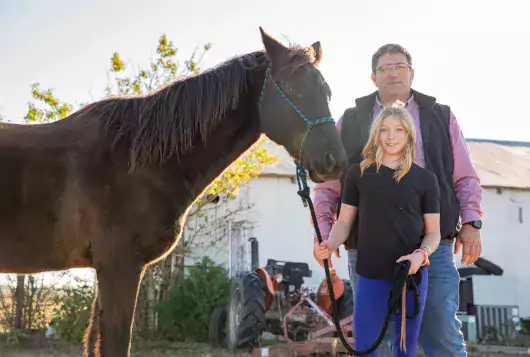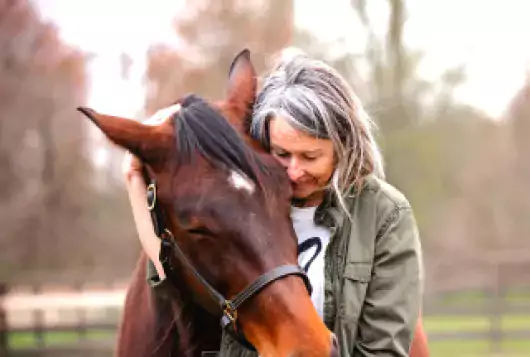Intake Diversion Program for Horses
Rehoming horses before they get to your adoption agency can be an important strategy for keeping your organization sustainable during challenging economic times.
Vera Valdivia-Abdallah, executive director of Love This Horse in Acton, CA, has helped place 94 horses in the last few years by assisting their owners with rehoming.
We talked with Valdivia-Abdallah about their intake diversion program and how other groups could try something similar.
Q: Do you advertise your intake diversion program or is it more word-of-mouth?
A: Because we have been successful in placing horses directly from one home to another, word has traveled, so it has been word-of-mouth. We always get requests for help—most of the time owners want to relinquish their Arabian horses to us. We cannot take in as many horses as we get requests for. So, what we started to do was to ask a lot of basic questions about the horses. Most of them are requests for Arabian horses, but we also get requests for help for other breeds.
Q: How many horses have you helped rehome without taking custody of them?
A: 94 horses to date.
Q: What are some successful strategies you use to help people place their own horses?
A: The main concern of owners is that they want to keep their horses safe. They are afraid that if they home the horses themselves, the horses may end up in a bad situation. They like the idea of the horses going to prescreened homes and that the horses leave on an adoption contract that has safety clauses in the contract.
Q: How do you help place the horses?
A: We share and post these horses on our Facebook page. We also have a separate Facebook page for geldings that breeders home with our help.
Q: What are some challenges with getting people to place their own horses?
A: Most of the time, owners do not have a social media presence to get the word out about their horse. Also, they are not able to screen adopters, which is a concern to them—and since our contract does have safeguards that the adopter must agree to, that puts the owners at ease. Ownership transfers to the new owner, but they agree to return a horse to us if needed. We also stipulate certain minimum care standards and have a jurisdictional agreement clause in the contract.
Q: What does the rehoming process look like for you?
A: Before we accept a horse into the rehoming program, we must visit and evaluate the horses. If they are not local, we have one of our prior adopters or other rescue organizations’ personnel go visit the horses. We do this because we have had some owners tell us that the horses are in great shape when they were not. In addition, we assess if the horse can be ridden or if the horse is sound. Basically, we assess the claims that the owner has made about the horse. Obviously, if the horse is an older companion horse or is a young horse under three, then we just assess for soundness, etc.
We have had cases where we send one of our trainers to ride the horses. This way, we get a clear picture of the horse. After all, we do not want to present a horse as rideable when he is not. We want the owners who need help to be honest about the horses they are trying to rehome.
In addition, we take photos and video of the horses so that potential adopters can get a better picture of the horse before expressing their interest.
The part that is most time consuming is the assessing of the horses. Depending where they are located, it can include driving time, etc.
Once we have good information and video/photos of the horses, we start posting them. We try to tell a story about the horse and the owners. Telling the story really helps. We have a supporter who is a professional photographer who volunteers to take photos of horses who are in her area, which really helps.
For example, we had a homing-assist horse all the way in Colorado, which is 1,000 miles from us. We had another rescue director go out and meet the horse, take photos, and collect information. We told the mare’s story: She had been an endurance horse, completing 50-mile races with her owner who now was in the last stages of Alzheimer’s. The owner no longer recognized her beloved horse. We received over 20 home offers, even though the mare is 23 years old. She was successfully placed with a lady in Colorado who uses the mare for light trail riding now.
Q: What should an organization know before offering rehoming/intake diversion services?
A: It is important to know that owners are often not correct in stating the horse’s condition or rideability. We do not think that is because owners are purposely dishonest, but because they sometimes block out the reality of the situation.
For example, we had an elderly lady contact us last year about a group of six older horses who she owned. She is in her 80s and her husband recently died. When we went out to see the horses, they were in terrible shape. This situation became a rescue situation. We provided the farrier and vet care that was needed and gave the woman horse feed and volunteers to help with the daily care of the horses. We stabilized the horses and then found them foster homes and permanent homes. The youngest horse was 26 and the oldest was 34. So, it is possible to help with older horses, not just rideable horses.
This was an extreme case, but it shows that it is important to meet and evaluate the horses before posting about them.
And doing the screening of potential new adopters along with having them sign a contract with safeguards is an important way to get buy-in from the current owners.
We have lots more on this subject:




